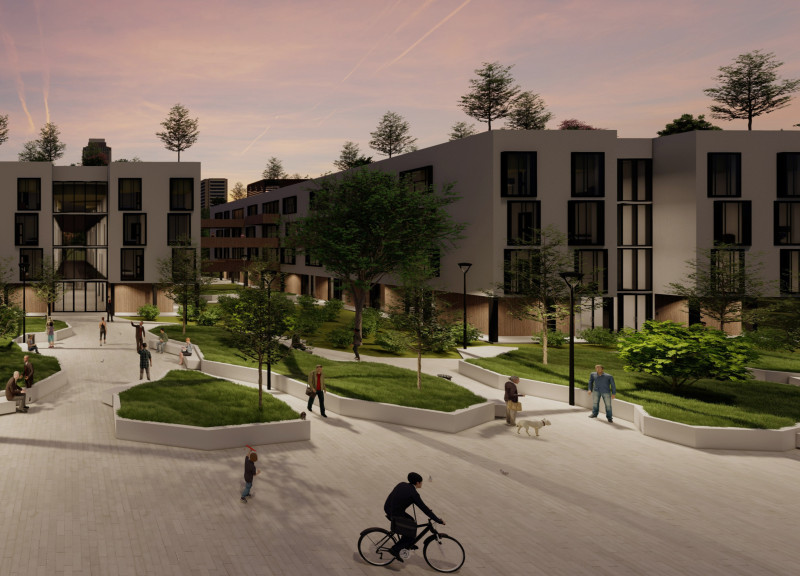5 key facts about this project
The functionality of the project hinges on its thoughtful spatial organization. At the heart of the development lies a central courtyard, designed as a communal hub where residents can gather, socialize, and participate in community events. Surrounding this communal core are residential units crafted to ensure comfort and privacy, allowing individuals and families to enjoy their own space while also remaining connected to their neighbors. By integrating essential amenities on the ground floor, such as a catering unit and cooperative spaces, Block 5x7 maximizes accessibility and practical use of the area, making daily living more convenient for all residents.
Materials play a crucial role in the aesthetic and functional aspects of Block 5x7. The projected scheme incorporates reinforced concrete for structural integrity, sophisticated wood elements for warmth and appeal, large glass openings to promote natural light, and green roofing systems to enhance environmental sustainability. These choices reflect a commitment to durability and ecological responsibility, ensuring that the building harmonizes with its surroundings while offering long-term resilience.
The architectural design also explores innovative approaches to spatial dynamics. The building massing is carefully considered; it utilizes a combination of heights and angular configurations to create depth and interest. This thoughtful layering of forms allows for an engaging relationship between built and natural environments. Additionally, the outdoor spaces have been carefully landscaped to incorporate native plants, promoting biodiversity and maximizing aesthetic value while reducing maintenance needs.
Access and circulation within Block 5x7 have been designed with inclusivity in mind, featuring pathways that facilitate mobility for pedestrians and cyclists alike. The integration of accessible routes reflects a necessary consideration for all residents, further underscoring the project’s community-centric approach. Every element, from the layout of communal gardens to the placement of seating areas, reinforces the idea of connectivity and shared experience.
One of the unique aspects of the Block 5x7 project is its modular assembly approach, which allows for flexibility in design. This adaptability ensures that the structure can respond effectively to the specific needs of its site or community, making it a versatile solution for urban challenges. By focusing on modularity, the design team has demonstrated an understanding of the evolving nature of urban living.
The project not only addresses contemporary social needs but also serves an important role in ecological design. Incorporating features such as solar panels and greywater recycling systems, the design minimizes the environmental impact of the residence, providing pathways toward self-sufficiency. This attention to sustainable practices is integral to modern architecture and reflects a growing trend towards responsible living in urban contexts.
Block 5x7 stands out as a thoughtful approach to residential design that prioritizes community engagement and environmental sustainability. The integration of shared amenities, diverse spaces for interaction, and a strong sense of place characterizes the architectural narrative of this project. The design encapsulates a vision of urban living where individual and collective needs coexist harmoniously.
For readers interested in exploring this project further, consider reviewing the architectural plans, sections, designs, and innovative ideas that underpin Block 5x7. Each element contributes uniquely to the overall design philosophy, providing deeper insights into how architecture can reshape communal living in urban environments.























